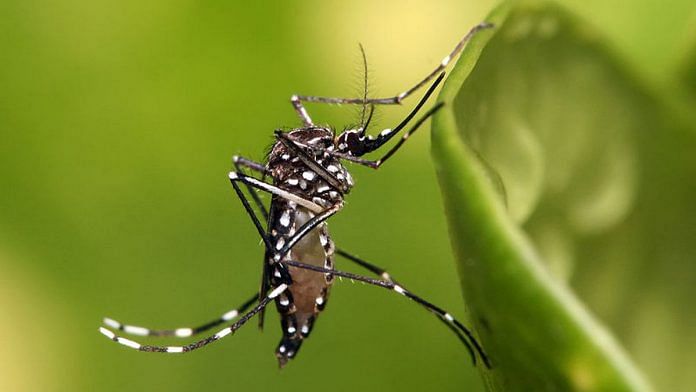New Delhi: A viral strain that originated in India and Bangladesh is likely to have caused the chikungunya outbreak in Thailand between 2018 and 2019, a new study has found.
Between 2018 and 2019, approximately 15,000 cases of chikungunya were recorded across 60 provinces in Thailand. No deaths occurred during this period.
Chikungunya is a viral disease transmitted to humans by mosquitoes and is caused by the chikungunya virus (CHIKV). The virus causes fever and severe joint pain, which is often debilitating and can vary in durations. There is no vaccine or specific drug that has been developed against the disease.
According to the researchers, different isolates of chikungunya have shown that there are three major lineages of the virus — East, Central and South African (ECSA), West African (WA), and Asian.
The team from Chulalongkorn University in Thailand collected a total of 1,806 blood samples from suspected cases of chikungunya from 13 provinces in Thailand. The samples were tested for the presence of the virus using real-time PCR tests and 547 of these tested positive for the infection.
The team conducted a genome analysis of the viral samples and found that the strain that circulated in the country in 2018-2019 belongs to the ECSA lineage with mutations that originated in south Asia.
Also read: Infecting mosquitoes with bacterium Wolbachia cuts dengue spread by 77%, new study claims
Double mutation of chikungunya identified in India
Every living organism is run by a predefined set of genes that ‘instruct’ cells on how to build proteins. Understanding the sequence of genes is, therefore, like cracking the code to the organism and how it functions.
Chikungunya virus is an enveloped RNA virus with nearly 12,000 bases or RNA “letters” in its length.
These letters — A, C, U and G — stand for adenine, cytosine, uracil and guanine, which are nitrogen-containing biological molecules that are the fundamental units of the genetic code. How A, C, U and G are arranged in a genetic code determines what proteins are expressed by the organism.
When a virus multiplies inside the cells of a living organism, it creates copies of the RNA. However, the process it uses to make these copies is not perfect and often tiny errors are introduced in the sequence. These errors are called genetic mutations.
The team found that the viral strain that caused the outbreak in Thailand had two mutations, E1-K211E, and E2-V264A along with E1-226A.
The earliest record of the mutation E1-K211E dates back to 1963, according to a research paper published in 2007 by a research team from the National Institute of Virology in Pune.
The strain with the double mutation, E1-K211E and E2-V264A along with E1-226A, was identified by a team from the International Centre for Genetic Engineering and Biotechnology in New Delhi in 2010.
An NIV study, in 2018, also pointed out that these two mutations together may be behind the resurgence of the chikungunya virus between 2017-18 in several parts of India, with Karnataka, Maharashtra and New Delhi accounting for a majority of the cases.
“There have been reports that chikungunya harbouring two mutations, E1-K211E and E2-V264A, along with E1-226A showed a significant impact on chikungunya fitness for the Aedes aegypti mosquito,” Yong Poovorawan, one of the researchers of the study, told ThePrint.
According to Poovorawan, recent confirmed cases of chikungunya were reported from the urban area in Thailand rather than rural areas. In the past outbreak, during 2008-2013, the burden of disease was higher in rural areas.
“This could result from the strain with E1-K211E and E2-V264A mutations, responsible for the Aedes aegypti vector’s higher fitness, which may facilitate viral circulation and persistence in the urban area,” he said.
Also read: Andhra villages see big drop in dengue, malaria, typhoid cases after pilot sanitation drive
Bangladesh connection
Further analysis of the whole genome sequences of six genome samples showed that the virus circulating in Thailand was closest to a strain circulating in Bangladesh in 2017.
“Overall, our results suggested that the recent outbreak of CHIKV (Chikungunya virus) in Thailand belongs to the ECSA genotype originating from other countries in South Asia, mostly Bangladesh,” said Poovorawan.
He added that there was a need for a multi-national consortium for genomic studies of Chikungunya.
“Understanding phylogenetic origin and viral genetic variation is important for providing information on CHIKV transmission, adaptation, and outbreak tracking, which is crucial for infection control and further development of specific drugs or prevention of CHIKV outbreaks,” the study author said.
The team now plans to study the impact of novel mutations (E1-K211E and E2-V264A with E1-226A) on human target cells by investigating viral infectivity, viral replication, and viral pathogenesis and compare it with other strains of the virus.
(Edited by Rachel John)
Also read: China targeting India? Import costs of paracetamol, antibiotics ingredients see 100% jump



